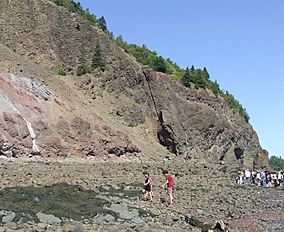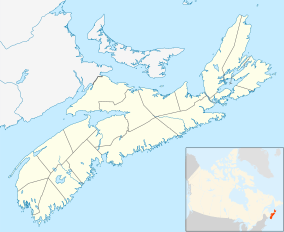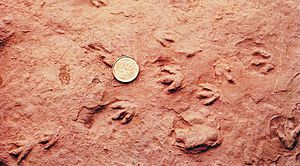Wasson Bluff facts for kids
Quick facts for kids Wasson Bluff |
|
|---|---|

Wasson Bluff's most easterly cliff showing reddish sandstone and grey basalt
|
|
| Location | Canada |
Wasson Bluff is a cool place in Nova Scotia, Canada. It has amazing cliffs along the north shore of the Minas Basin. These cliffs are about 5 miles (8.0 km) east of Parrsboro.
The cliffs stretch for about one mile (1.6 km). They are made of rocks that are 200 million years old! These rocks hold tons of fossils. Scientists have found over 100,000 bones from Canada's oldest dinosaurs here. They even found the smallest dinosaur tracks ever!
These fossils are super important because they come from a special time. This was when the Triassic and Jurassic periods met. A huge event, called a mass extinction, happened then. This event led to dinosaurs becoming the main animals on Earth. It also helped other animals like fish, crocodiles, frogs, and mammals develop. Their relatives are still around today! The strong tides in the Minas Basin constantly uncover new fossils.
In 1990, Paul E. Olsen, a paleontologist who studied Wasson Bluff, said: "Every time I stand before these cliffs, I feel dwarfed by the immensity of time."
Contents
What is the Geology of Wasson Bluff?
The cliffs at Wasson Bluff are on the edge of an ancient valley called the Fundy Basin. This valley formed when the supercontinent Pangaea started to break apart about 225 million years ago.
As the Earth's plates moved, they cracked. Blocks of land either sank or rose along fault lines. This created twisted layers of rock that are now at strange angles.
The orange and red sandstone you see at Wasson Bluff formed from rivers. These rivers were full of sediment from heavy rains. Other deposits came from wind-blown sand dunes. Some also came from the bottoms of shallow lakes that once filled the basin.
As Pangaea broke apart, hot liquid rock (magma) rose to the surface. It erupted as lava flows. This massive volcanic activity created the greenish-grey columns and grey-black blocks of basalt. These rocks make up large parts of the cliffs.
Amazing Fossil Discoveries
Tiny Dinosaur Tracks Found at Wasson Bluff
On April 10, 1984, a fossil hunter named Eldon George made an amazing discovery. He was riding his all-terrain vehicle along the shore. He stopped to hide from the wind. As he leaned over, his sharp eye spotted tiny tracks.
Using a jackknife, he slowly uncovered five fossil trackways. They were in a piece of sandstone that was 16 by 14 inches (41 cm × 36 cm). These three-toed footprints were the size of a penny! They were made by a theropod dinosaur as small as a robin. These were the smallest dinosaur tracks ever found!
Eldon George has made many discoveries since the 1940s. His finds include many fossilized amphibian and dinosaur prints. You can see them, along with the tiny dinosaur tracks, at his Parrsboro Rock and Mineral Shop and Museum. He also found a 17-inch (43 cm) track at Wasson Bluff. This track might have been made by a primitive, two-legged, crocodile-like creature that was almost 20 feet (6.1 m) long!
Rich Fossil Beds and Ancient Life
In January 1986, American paleontologists Paul Olsen and Neil Shubin announced a huge find. They had found hundreds of thousands of bones at Wasson Bluff. This was the largest fossil discovery in North America from 200 million years ago. This time is known as the Triassic-Jurassic boundary.
During this period, huge lakes of lava poured from cracks in the Earth. This happened as the supercontinent Pangaea broke apart. Some scientists think these volcanic eruptions and their gases caused a mass extinction. Nearly half of all creatures on Earth died out. This ended a time when huge reptiles ruled. It allowed dinosaurs to become the main animals. The sandstone and basalt cliffs at Wasson Bluff formed during this time. They hold fossils of creatures that lived both before and after the mass extinction.
In 1984, Neil Shubin found the jaw of a mammal-like reptile called a trithelodont. This was the first time one was found in North America. The next summer, he and Paul Olsen, along with other scientists, found 12 complete trithelodont skulls. This discovery has helped scientists understand how mammals first appeared. They also found many other fossils. These included teeth from small, bird-hipped dinosaurs, skulls of lizard-like creatures called sphenodontids, and ancient crocodile bones. They even found fossilized fish and shark bones!
Rules for Collecting Fossils
You need a special permit to collect fossils or use rock hammers at Wasson Bluff. This area is protected by Nova Scotia's Special Places Protection Act. This law helps keep important cultural, historical, and environmental places safe. It also protects sites that are important for scientific research.



